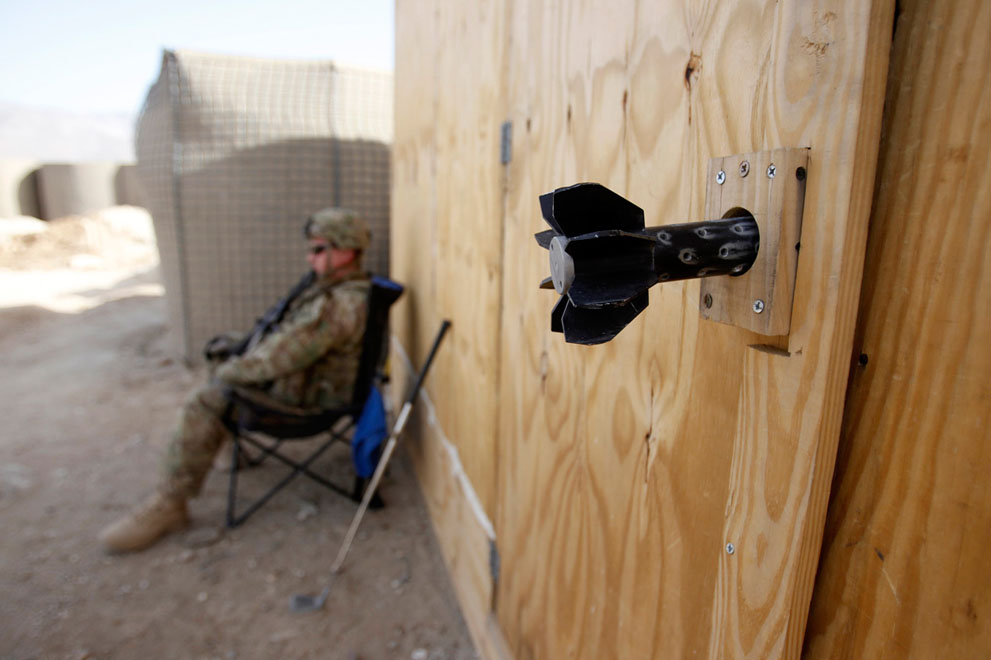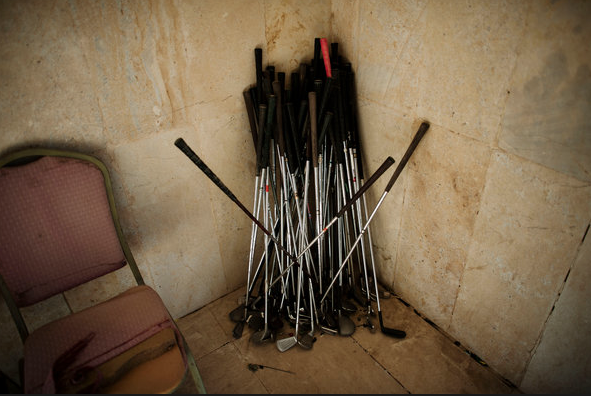There a a lot of photos from Afghanistan, which is not known for a wide variety of landscapes–or cityscapes, for that matter–and so one can understand why a photographer would look for the odd angle or unusual object.
This is not a photograph likely to win an award, but it speaks volumes. The only thing in focus is a cheap plywood door and its improvised door knob. That’s the tail end of a rocket, one of many stray parts likely to be strewn around a working combat outpost. In WWII this detail might have come with a narrative of Yankee ingenuity and the egalitarian ethos of a Bill Mauldin cartoon, but that war hadn’t lasted ten years.
The line of sight loses focus as it extends down the wall, where it picks up the inert soldier in his camp chair and then runs into that grey fabric cover on some undefined storage space. Beyond that is more grey, including the stony ground, storage silos, and a wall, all harshly lit or left in dull shadows. Not exactly an image that you will see in an Armed Forces ad. This is your back lot, Dogpatch, lost world army, stuck in time in some place that, if not forgotten by God, has been forgotten by just about everyone else.
Which is why one might think about the things they will leave behind, and what that says about why and how they are there. However successful the mission, I don’t think the 13th Cavalry is going to crate up that outpost and ship it back home. And when they leave it behind, it’s not going to last long. Already slap-dash and not made to last, this is not evidence of nation building. The fact that the rocket is inert adds a lame joke, but it wouldn’t take much to tear through that shed. Not to worry, though, it is more likely to be abandoned than attacked, while the real danger is waiting to maim and kill the minute anyone starts walking outside the perimeter. No wonder a soldier might want to stay put in that chair.
Or, if wanting to pass the time more enjoyably, take a few swings with a golf club. Yes, that is the second odd metal object in the photo. I’m not sure which is more implausible: that a golf club would be casually leaning against the wall, or that the fully equipped soldier would be working on his game, or that anyone would be hitting golf balls off that rock strewn field into the impossible fairways of Laghman province. But the implausible we do today, because the insane is already second nature.
These are golf clubs that were left behind when the US pulled out of one of its bases in Iraq. The walls of the building are marble, but the scene nonetheless is shabby, sad, and forlorn. A study in excess–why one club would be there is strange enough, much less dozens–it becomes a small monument to misspent resources, misplaced priorities, and the futility of this imperial project.
The camera has a special relationship with objects: capturing their quiet but persistent eloquence amidst the welter of events. When objects are left behind, they acquire the special resonance of ruins, and with that an allegorical voice that can speak of the decline and fall of civilizations. America isn’t gone yet, but it may be losing its way. And if it is to be known by what it leaves behind, those in Iraq and Afghanistan surely could ask whether it ever really knew where it was.
Photographs by Erik De Castro/Reuters and Andrea Bruce/The New York Times.


Discussion